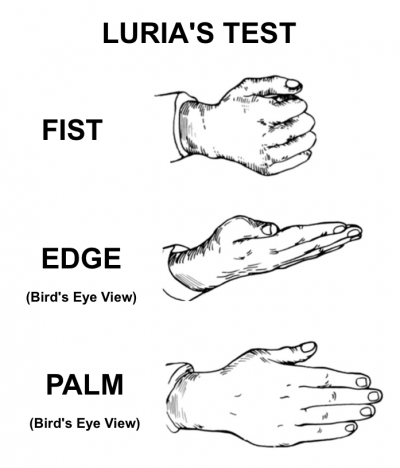- Last edited on November 29, 2021
Luria Sequence (Luria's Test)
Primer
Luria's Test (“fist-edge-palm” test or Luria Sequence) is a task that requires a patient to imitate three hand motions performed by a clinician. Luria's test is part of the Frontal Assessment Battery (FAB) battery of tests. Luria's test assesses for frontal lobe (i.e. - executive) dysfunction or damage, as patients will often have difficulty with fine motor skills and sequencing motor skills. Specifically, it is designed to assess different aspects of executive function, including execution of a learned motor program, inhibitory control, attentional flexibility, working memory, and motor planning.[1]
History
The Luria sequence was developed by Russian neuropsychologist Alexander Luria. Luria observed that patients with severe frontal lobe lesions were often unable to alter their responses to a motor task when additional steps were added or if the order of steps was changed.[2]
Procedure
With fingers fully extended and the patient following, the examiner makes the 3 following motions in sequence, and asks the patient to follow along:
- Makes a fist with the right hand
- Then makes a chopping/cutting motion with the right hand, with the edge of the hand hitting their knee or on a table (i.e. - “Karate Chop!”)
- Then puts palm down with fingers extended
The examiner and patient then repeat this motion together 3 more times. The hand motions can be reinforced by counting from 1 to 3 along with each segment, or by saying “cut, fist, and slap.” Patients are then asked to repeat these sequence of movements unguided by the examiner several times.[3]
Interpretation
- The patient should be able to complete
3complete motor sequences in the correct order without making an error. If they cannot perform this, a sequencing deficit should be suspected.- Older adults may require repeated modelling by the clinician to acquire the appropriate sequence.
- Although this test is brief and does not require test materials, it has limited published norms across the adult lifespan (see Frontal Assessment Battery (FAB) for a scoring guide).
- If a patient cannot learn a Luria sequence or exhibits sustained, perseverative responses, this would clearly represent impaired performance.
- However, whether more subtle sequencing errors is abnormal for age is much more challenging as there are no clear norms for this.[4]
Limitations
Performance on the Luria sequence may be affected by other factors such as physical disability, weakness, medications, sensory deficits, or musculoskeletal disorders affecting the joints, muscles, or bones. Also, there is limited normative data, and it is not a comprehensive test by itself.[5]
